A self-study, self-paced course where you can learn how to paint in watercolor by watching video lessons and doing assignments
$297 USD
ENROLL NOWA self-study, self-paced course where you can learn how to paint in watercolor by watching video lessons and doing assignments
$297 USD
ENROLL NOWOne-to-one, unlimited and custom-tailored to your skills and needs Personal Tutoring by the Watercolor Academy teachers
$997 USD
ENROLL NOWBy Anna Ivanova
The topic of today's video lesson is a female bullfighter riding a horse. I will work on the horse's movement, its anatomy and coat texture, and I'll also show how to paint a background. Here is the finished piece I will have by the end of this lesson.
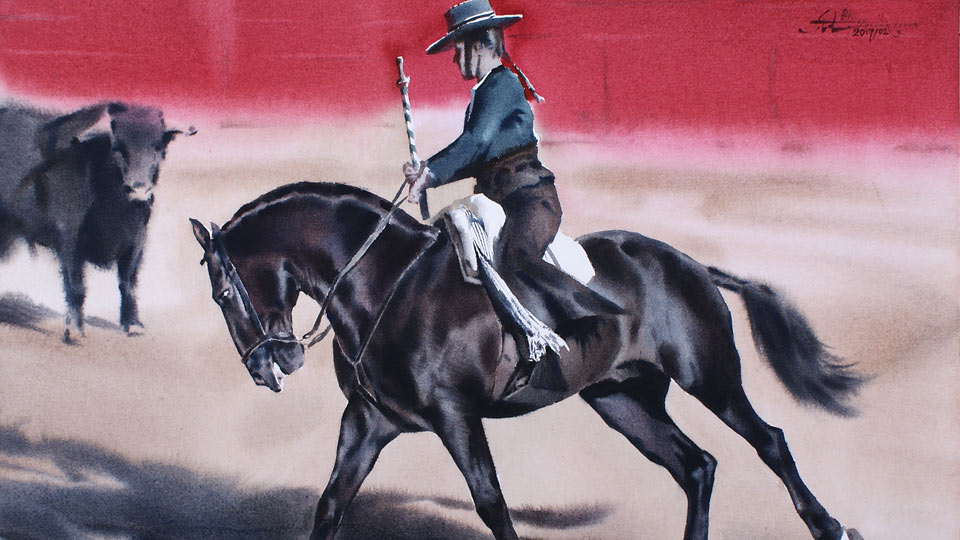
This watercolor is dedicated to Lea Vicens, a beautiful and fearless bullfighter, the only elite rejoneadora in the world. She performs bullfighting while riding a horse and considers it dancing with the bull. Bullfighting is her dedication, her passion, and her life. She spends from ten to twelve hours riding on horseback every day. She's not the only female bullfighter, but she's the world's number one in her dangerous profession.
I begin this artwork by wetting both sides of the watercolor paper with a wide, flat brush. It is cold-pressed, 100% cotton watercolor paper, which has 300 gsm weight. For the color of the horse, I will be using the following pigments: ultramarine, burnt umber, sepia, burnt sienna, and a bit of red. This very limited palette is capable of producing a very wide range of different colors when those pigments are mixed together in various proportions. The paper is moist; its surface is almost dry and cold to the touch. Water is trapped between the fibers of the paper and also a very thin layer of moisture remains between this sheet of paper and the plastic board. This moisture not only slows down the drying time but also works as an adhesive, keeping the sheet of paper firmly on the board.
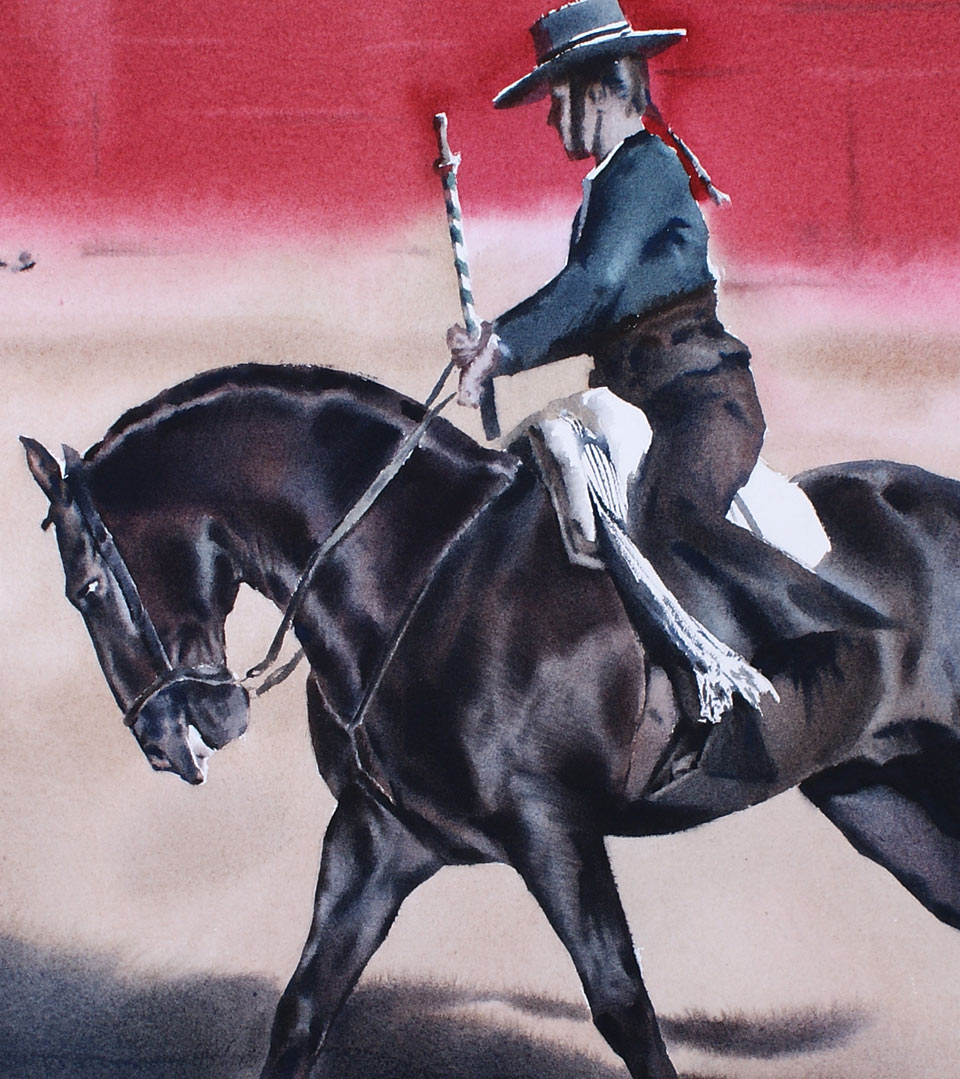
I will do this artwork alla prima which means I will finish it in one session, and all figures of this composition will be done in the dry-brush-on-moist watercolor painting technique. "Dry brush" doesn't literally mean that the brush is totally dry. The brush contains very little water, somewhere between damp and moist. Its belly is drier than the tip because I load the mixed paint not on the whole brush but only on its end. Every time I put a new bit of pigment on the brush, I absorb any excess water from the brush's belly with a paper towel. This keeps the brush moist. Moist paper takes the pigment from the brush tip readily. Every brushstroke stays in place without spreading out because of the right balance of water on paper and on the brush.
The painting process is very simple. I begin with the color of the highlight. In this case, it is a light gray tint. The mid-tones are warmer and I add the brown mix next to the light gray areas. This first wash serves as the underpainting. On top of this underpainting, I apply much darker tonal values in full saturation. Such application of darker colors can be done in one or more layers. Because I'm using the dry-brush-on-moist painting technique, it is more convenient to work on a small area of an artwork from beginning to end and then move to another area. This prevents accidental smudging of paint with my hand.
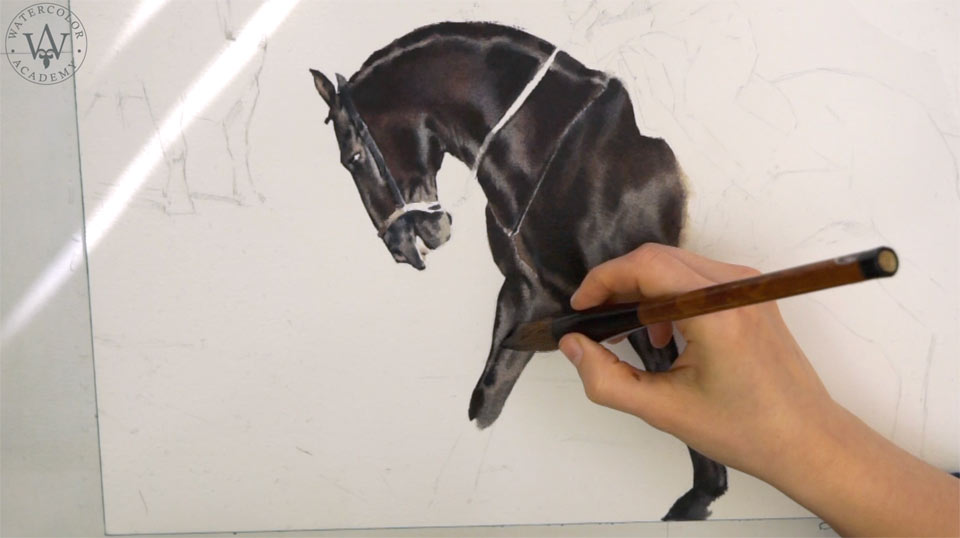
You may notice once again that I started with the light gray tint and next to this gray color, I am applying a much warmer mix of pigments in a series of short brushstrokes. The border between these two colors can be diffused with a clean brush. On top of this underpainting, I add a second layer in full strength. For all layers, I am keeping the brush just moist enough to hold liquid paint without overloading it with water. This allows me to keep the paint flow under control. In this lesson, I'm talking so much about the water balance because without the right balance, the dry-brush-on-moist technique would not be possible. I'm more relaxed about the choice of colors because it is less important than tonal values. For example, for cool shades, I am adding a blue pigment into the mix. It doesn't really matter which blue pigments are used here. Instead of ultramarine, it could be phthalo blue, Prussian blue, or indigo, or any other blue paint you like. Of course, various blues will give different chromas to the mix. But in all cases, whatever blue pigment you go for would do the same job of making the mix cooler and darker.
As long as you manage the correct light and dark contrast, this horse will look like the horse no matter which blue pigment has been used for its cool shade. Of course, different paints will give different appearances. But whatever color it is, it will be perceived as the choice of the artist. However, if an artist makes incorrect tonal values, such a piece would look unprofessional. I am now painting the horse rider. Lea Vicens mounted a horse for the first time at the age of four. A quarter of a century later, she became a rejoneadora, a horse-riding bullfighter. French-born, Lea moved from southern France to Spain where she trains as a bullfighter and looks after her horses. There are very few who choose the dangerous profession of a bullfighter and she is the only one in the world at her level. It is a very hard job that requires a lot of practice. She developed her unique style of horse riding and, after many years of practicing, she is at the top of her career. She has won a lot of trophies. For example, in the 2012 season, she took part in 27 corridas, winning 60 bull ears and 10 tails as trophies. Her experience will be written about forever in the history of bullfighting.
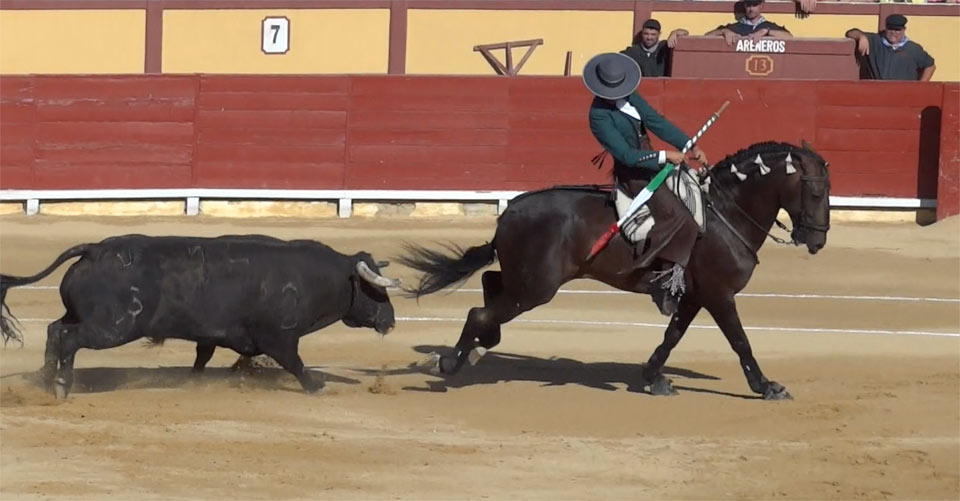
Coming back to the artwork, I have to mention, the paper is still moist and, with the dry brush, I can paint well-defined details that stay sharp despite the paper being moist. Little by little, I am completing the rider and the horse. To create the silky texture of the horse's coat, I must make a sharp contrast between light and dark areas. The horse has a dark color but highlights of the coat are rather light. There is a very short gradation from light to dark tones which makes the coat's appearance silky.
The way I am applying the paint on the paper resembles a tonal drawing style rather than picturesque painting. Such a graphical approach gives greater control over how the artwork develops. For example, gravity and excess water do not interfere with the painting process. The brushstrokes do not flow and stay where I place them. This gives a high degree of predictability, which is the main advantage of dry-brush-on-moist watercolor painting technique. Because of the nature of this technique, the paint has to be applied in short brushstrokes with the tip of the brush. This is a great way to depict different textures, like the horse's coat, for example. The paper is gradually drying and I have to re-wet it, adding clean water with a flat, wide brush to the reverse side of the sheet. I am preparing a creamy mix of burnt umber with red paint, to use this red color for the background. I apply the mix on paper with a flat natural soft-hair brush, covering big areas with wide brush strokes. In places where the background borders the horse rider figure, I have to use a smaller brush with less water to make sharper borders. For the sand of the arena, I'm mixing burnt umber, raw sienna, and a tiny amount of peacock blue. This mix is also applied with a wide, flat brush to cover big areas at once.
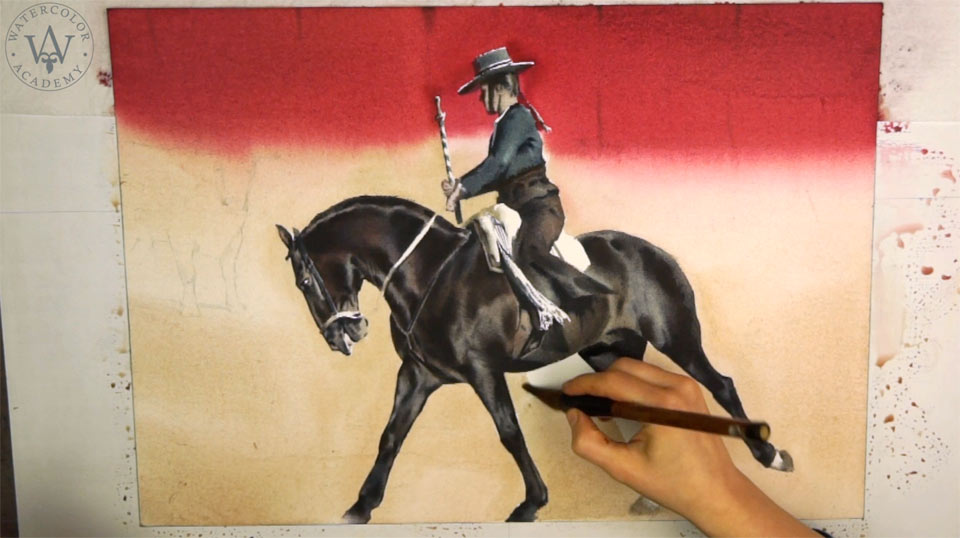
Where the background borders the figure, I'm using a smaller dry brush with less water to keep the borders between colors sharp. Adding backgrounds is a skill that didn't come to me overnight. In fact, I spent several months practicing and mastering it. The key here is to have the correct balance of water on paper and on the brush to avoid backruns when there is more water than needed, and to achieve a smooth tone without visible brushstrokes which could be the case when there is not enough water. The feeling of the correct balance can only be obtained with practice.
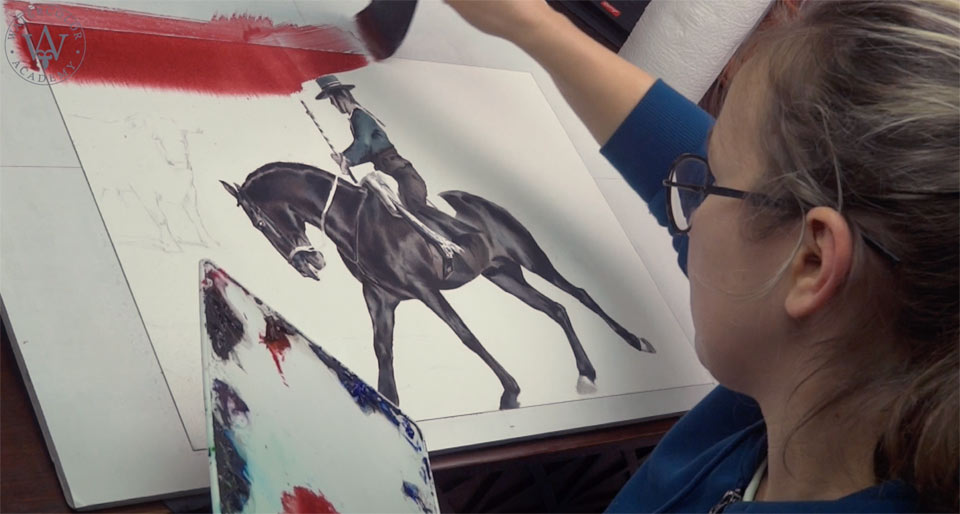
You may see the paint I'm mixing on the palette is quite thick. It does not flow and run down when I put the palette on its side. This is one of the secrets of the dry brush technique.
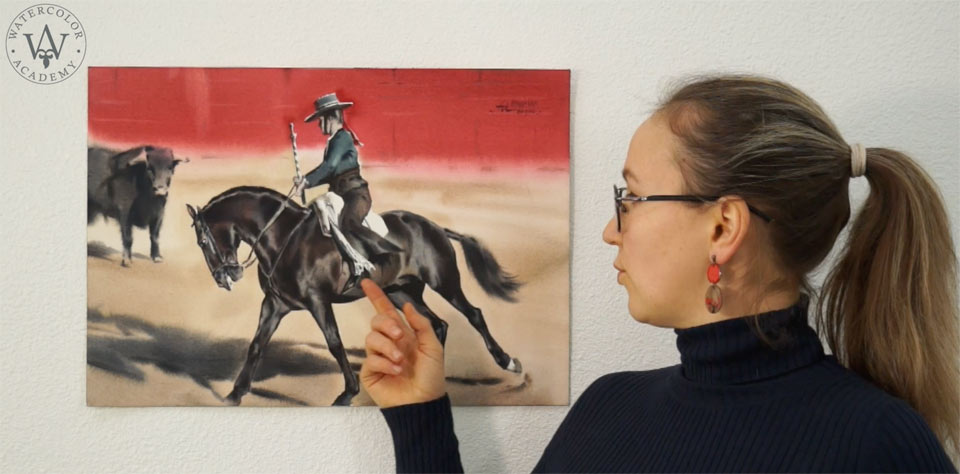
Because the background is painted to the paper's edge, it is better to put a paper towel under the sheet. It will help prevent backruns which otherwise might occur next to the edges. The shadow cast by the horse will anchor it to the ground...
A self-study, self-paced course where you can learn how to paint in watercolor by watching video lessons and doing assignments
One-time payment - Lifetime membership
$297 USD
One-to-one, unlimited and custom-tailored to your skills and needs Personal Tutoring by the Watercolor Academy teachers
One-time payment - Lifetime membership
$997 USD